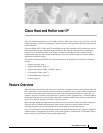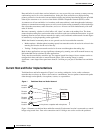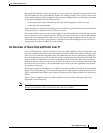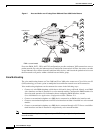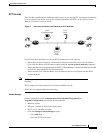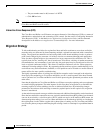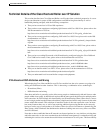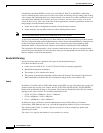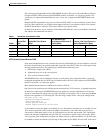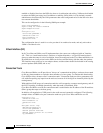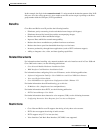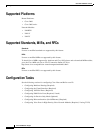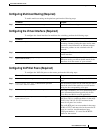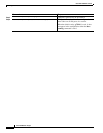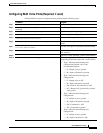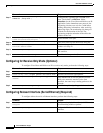
Cisco Hoot and Holler over IP
Feature Overview
8
Cisco IOS Release 12.1(5)T
is handled by the onboard DSPs on each voice-card (NM-1V, NM-2V or NM-HDV). Arbitration
involves identifying the various sources of the voice stream, and mixing involves taking some of those
voice streams and combining them into a single-sourced voice stream. Cisco Hoot and Holler over IP
can handle many inbound voice streams, but it only arbitrates and mixes three streams to be heard
within the Hoot group. This value works fine in most applications, because beyond three streams two
things happen in normal human conversation:
1. People are not able to distinguish the content of more than three streams.
2. People normally stop speaking if they hear others talking ahead of them.
Note The mixing functionality does not do a summation of the voice streams.
As previously mentioned, the DSPs in Cisco Hoot and Holler over IP do mixing for up to three streams.
This fact is important when network administrators consider how much bandwidth they should plan for
in their Cisco Hoot and Holler over IP network. This is especially crucial when planning WAN
bandwidth, which is often much more expensive and much less available than LAN bandwidth.
The advantage to this functionality is that a network administrator never has to be concerned about
provisioning voice bandwidth for more than three times per call bandwidth for each WAN site, which
helps to simplify overall network planning.
Bandwidth Planning
Four main factors must be considered with regard to bandwidth planning for
Cisco Hoot and Holler over IP:
1. Codecs used for VoIP (G.711, G.726, G.729 and G.729a are currently supported).
2. Bandwidth management techniques.
3. The number of voice streams to be mixed.
4. The amount of guaranteed bandwidth available on the IP network. This includes both LAN and
WAN bandwidth, and should take into consideration things such as Frame Relay CIR.
Codecs
By default, Cisco IOS sends all VoIP traffic (media, using RTP) at a rate of 50 packets per second. The
packets include not only the voice sample, but also an IP, UDP, and RTP header. The IP/UDP/RTP
header adds an additional 40 bytes to each packet. The amount of bandwidth each VoIP call consumes
depends on the codec selected. The resulting bandwidths can be:
• G.729 or G.729a = 3000bytes * 8 bits = 24Kb/call
• G.726 = 6000bytes * 8 bits = 48Kb/call
• G.711 = 10000bytes * 8 bits = 80Kb/call
In addition to these calculations, network administrators must consider the Layer 2 headers
(Frame Relay, PPP, Ethernet, and so on.) and add the appropriate number of bytes to each packet.
The following table, Table 1, assumes a payload size (bytes) of 20 ms samples per packet with
50 packets per second.
The value of n is equal to the number of voice streams in a session.



